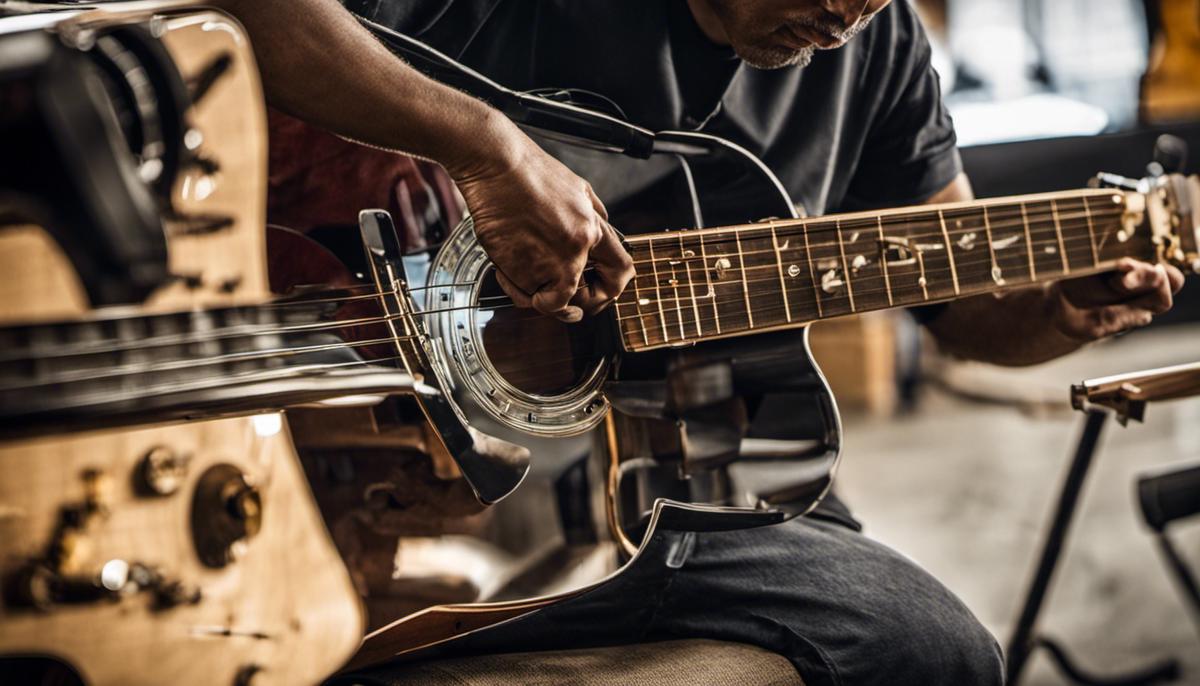Experiencing your guitar’s delightful chords and arpeggios come to life is certainly a gratifying moment for any guitar enthusiast. However, every musician, whether a novice or a seasoned player, is all too familiar with the unexpected guitar sound woes that can creep in, tainting this beautiful moment. From pesky string buzzing, temperamental intonation issues, unsettling electronics troubles, every part of your beloved instrument can contribute directly to the quality or problem of your guitar’s sound. This comprehensive guide will explore ways to identify these issues, delve into simple maintenance and setup procedures aimed at restoring the guitar’s sound integrity, and introduce basic principles of sound engineering, which not only help troubleshoot but also enhance the overall sonic output.
Identifying Guitar Sound Problems
Strumming Through Troubles: Addressing Common Guitar Sound Issues
As a conduit of harmony, a guitar is more than an instrumental wonder; it is a vessel that carries the melody of the soul. Just as the voice of a singer expresses a broad spectrum of emotions, the resonating sound of a guitar strings vibrates into the hearts of listeners, awakening shared feelings and creating intimate connections. To keep these emotions flowing, it’s key to understand and address the common issues that can affect the sound of a guitar.
The sheer allure of a guitar plucking a melody is reliant on its proper maintenance, akin to a well-tuned orchestra. The secret often lies in the very heart of the instrument – the strings. They are the primary source of the sound and are, therefore, predominantly the ones to blame for any discrepancies. Changing guitar strings is an unrivaled ritual among the musical community that ensures optimal sound quality, and should never be overlooked.
However, issues may run deeper than the surface. Intonation, the accuracy of pitch in playing, is an essential aspect to consider. Sometimes a note may sound off even when the guitar is perfectly tuned; this could be due to improper intonation. Regularly checking this, and potentially getting it professionally fixed if a problem emerges, ensures the soulful symphony continues without disruption.
Beyond intonation lives a less conspicuous yet influential contributor to the quality of sound: the guitar’s action. Action refers to the distance between the strings and the fretboard. A high action may result in a buzzy or muted sound as it becomes tougher to press the strings down onto the frets correctly. Conversely, an exceedingly low action might cause the strings to buzz against the frets. Finding an optimal balance is a delightful dance between comfort and sound.
Guitar pickups also play a considerable role in the symphony of strings, especially when electric guitars are at the forefront. Guitar pickups are magnets that capture the strings’ vibrations and convert them to an electrical signal—any fault or misalignment in pickups alters the sound drastically. Thus, routine checks and maintenance are undeniable constituents in the recipe for seamless guitar sounds.
The art of playing the guitar is a symphony of strings that create a harmony of human emotion, encapsulating the spirit of music in its purest form. Understanding and addressing the common issues that can affect the sound of an instrument are the keynotes to ensure the music continues to resonate, inspire, and evoke. Indeed, as with any art form, for the sweet sound of success, one must tune in to the minor details. Radiate the beauty of sound; take charge of your guitar’s melody, and let the world listen to your unspoken verse.

Guitar Maintenance and Setup
Maintaining the Heartbeat of Music: How Regular Care Transforms the Guitar’s Tone
Delving into the harmonious world of music, a strumming guitar forms a rhythm that guides the orchestra, a pulse that brings people together. Just as a virtuoso knows every cadence, every note, and the subtle nuances of their chosen instrument, so too should they understand how meticulous care and correct setup profoundly impacts the guitar’s overall sound quality.
An overlooked aspect of guitar accuracy and sound quality is the instrument’s truss rod. Found in most guitars, the truss rod controls the amount of bow in the neck. This adjustment directly influences the guitar’s pitch accuracy, particularly in the midrange of the fretboard. Defects in the truss rod can cause fret buzz, loss of sustain, or intonation issues, which drastically decreases the resonating beauty that one seeks from the guitar strings.
Moving on to an often underappreciated region of the guitar: the nut and saddle. In simple terms, the nut guides the strings onto the fretboard from the headstock, while the saddle does the comparable job at the bridge. Both the nut and the saddle play key roles in the guitar strum’s precise tone. Materials vary widely – from bone to plastic to graphite – each lending a different tonal fingerprint to the guitar’s voice. Erratic wear or improper setup can lead to detuned guitars and sub-optimal sound quality – the perfect antithesis of true music lovers’ passions.
Feel the grooves of the frets under your touch, the places where fingertips linger and let out the melodies that make hearts soar. Faulty or worn-out frets not only hinder performances and cause physical discomfort but also profoundly affect a guitar’s pitch and overall tone. Regular care of the frets, including proper leveling and dressing, prevents buzzing and ensures clear, beautiful tones at every fret.
Amplifying the acoustic resonance in electric guitars, the potentiometers and capacitors are akin to the conductor directing the opera. They modulate the voltage passing through the guitar pickups, allowing a bespoke shaping of high-frequency response and overall output. Inconsistent performance or rusting can significantly affect the robustness of tones produced.
A proper setup and diligent maintenance of a guitar can be likened to offering love and respect to your fellow band members. Beyond functionality, these acts enhance creativity, enabling musicians to compose and deliver astounding symphonies that touch the soul. To seek quality sound, one must give quality care. From the truss rod to the frets, potentiometers to capacitors, every guitar component is part of a complex symphony, all working in unison to produce captivating music, the universal language that unites hearts – a beautiful tribute to the time-honored tradition of song and rhythm.

Sound Engineering Basics
Guitars, in their captivating resonance, offer a limitless repertoire of melodies that touch the soul.
Each guitar, analogous to a distinct voice, holds the potential to express an array of emotions and stories through sound. Impeccable sound recorded from a guitar isn’t just a product of competent craftsmanship and maintenance, ending on the application of sound engineering techniques.
One fundamental technique vital in yielding superior guitar sound during recording is exploiting microphone positioning. The placement and arrangement of microphones can significantly affect the final recorded tone. The tried-and-tested technique of close-miking captures the direct sound of the guitar’s speaker whilst reducing the influence of room acoustics. Employing a multi-mic technique allows the blending of different tones to create a more complex and rich sound. An appropriately distanced room mic can also capture the sonic character of the room, adding depth to the recording.
Directionality of microphones also plays an indispensable part. Directional condenser microphones or dynamic microphones pointed towards the center of the speaker can capture more bright, clean tones. On the other hand, aiming towards the outer edge of the speaker yields warmer, smoother tones. Using a combination of the two can balance the brilliance and warmth in the guitar sound. Equalization (EQ) is a powerful tool that aids in smoothening the frequency response of the guitar in a mix. However, it’s imperative to use EQ judiciously, as excessive EQ could lead to a loss in the natural harmonics and character of the instrument.
While recording, removing extreme low frequencies (cutting high-pass filter) can reduce unwanted noise. Boosting or cutting certain frequencies can emphasize or downplay certain features of the sound. A key component of amplifying the guitar’s tone is the usage of compression. Compression enables control of the dynamic range, making loud parts quieter and quiet parts louder, creating a balanced and controlled sound output. It’s crucial to use compression moderately to maintain the natural dynamics and articulation of the guitar performance. Another magical tool in the sound engineers’ box is the reverb. With its capacity to simulate spaces, reverb can add an engulfing ambience to the guitar. Different types of reverb yield different textures and environments for the guitar sound, from a small room to a large hall.
Lastly, the power of testing and experimentation must never be underestimated in guitar recording. Changing the guitar, using different picks, adjusting the player’s technique or attempting different amp settings can all contribute to the end result. There’s no singular absolute method; it always depends on the specific sound one is aiming to achieve. Hence, the alchemy of stellar guitar recording is a fusion of technical understanding, keen listening, and creative experimentation. Sound engineering strategies like microphone positioning, prudent use of EQ, compression and reverb, and continuous experimentation can elevate the guitar’s sound from ordinary to extraordinary, enabling the guitar to narrate captivating tales in its entrancing language of melody.

Mastering your guitar is not only about possessing the finesse to play intricate solos or complex chord progressions. It also includes understanding and troubleshooting any sound problems that may arise, compromising the beauty of your performance. Through regular maintenance, a fair appreciation of the guitar setup, and acquainting oneself with some vital sound engineering basics, you can ensure that your recording sessions encapsulate the very essence of your guitar’s true sound. Initiating a recording with sound issues could potentially degrade the entire recording process. In contrast, a well-maintained instrument, coupled with astute engineering basics, promises rewarding results- it’s worth all your dedicated effort and painstaking tuning. So, keep those strings in harmony, ensure your frets are in top shape, and master the sublime art of sound recording, cementing your place in the awe-inspiring world of music.

Comments.
Currently there are no comments related to this article. You have a special honor to be the first commenter. Thanks!